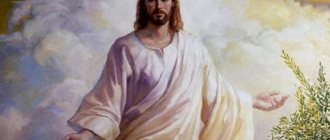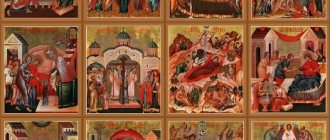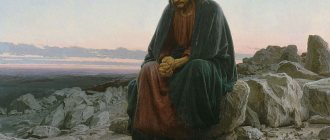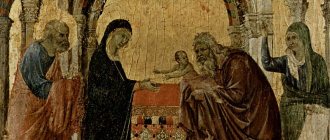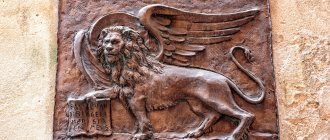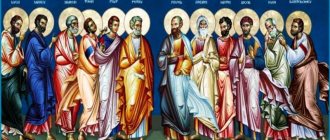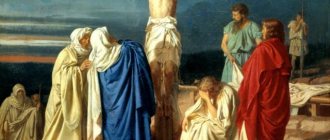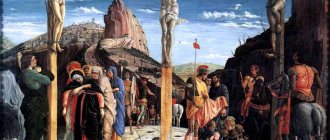A small waterway, lost in the sands and winding among the rocks of the spurs of the Lebanese mountains, is the natural border between the Muslim and Jewish worlds. Two thousand years ago, it became a mystical line that divided human history into “before” and “after.” The name of the Palestinian river has become a common noun. “Jordan” means any body of water or place where the rite of the Great Blessing of Water is performed on the feast of Epiphany.
What does the word baptism mean?
In the Slavic tradition, “baptism” means participation in the life of Christ. In ancient times this word was pronounced like this - baptism. This is understood as a certain mystical action related to Christ and performed with His participation. The first meaning of the term “baptism” means a church sacrament (not a rite, but a sacrament), through which a person becomes a member of the community of followers of the life and teachings of Jesus Christ.
In the Hellenic tradition, this action is called the word βαπτίζω (vaptiso), which means “immerse” or “dip”. Where in the Slavic translation of the Gospel it is written that John the Baptist performed baptism in the Jordan River, one should understand “immersion”: “... and all Judea was baptized (immersed, immersed),” etc. The Holy Prophet John did not invent this ceremony himself, but he performed these actions on the basis of the Old Testament Jewish religious rite. Similar rituals can be found among many nations. For example, Hindus take sacred baths in rivers.
The site of the ascension of the prophet Elijah
And Elijah said to him [Elisha], “Stay here, for the Lord is sending me to the Jordan” (2 Kings 2:6).
As they walked and talked along the way, suddenly a chariot of fire and horses of fire appeared and separated them both, and Elijah was carried into heaven by a whirlwind (2 Kings 2:11).
The prophet Elijah did not die - God took him alive to heaven. The place of the prophet’s ascension coincides with the place where John the Baptist lived in the desert. Therefore, having heard John's sermon, people asked him: is he not Elijah, who should come to earth again? In the 6th century, several churches were built here, which eventually collapsed due to constant earthquakes. Surprisingly, the name of the monk who built the monastery in 592 has even been preserved - Ritorios. This is indicated by the inscription in Greek, laid out in mosaics on the floor.
Ancient Jewish custom
The Law of Moses prescribed ablutions for any defilement: touching a dead person, eating forbidden food, a woman after bleeding, etc. According to the rituals of the ancient Jews, any person of non-Jewish blood could join the Jewish faith. Such a person was called a proselyte. For this case, a special ritual was prescribed for the acceptance of people of other faiths into Judaism, which also included ablution. In modern language this can be called the baptism of proselytes.
In all cases, ablution was performed by completely immersing the head in a body of water. This was a symbolic action and had a mystical meaning of cleansing from sins. Only “water from God” had purifying properties: flowing from a source or collected rain.
John's Baptism
Jewish rituals were known to John. At a certain time, he comes to the banks of the Jordan River and proclaims that the time of God's judgment is coming. The righteous will be rewarded with perfect eternal life in the Kingdom of God, while the sinners will be subject to eternal punishment. John preached that you can only be saved from punishment by repenting of your vices and correcting your life. “Come to the Jordan,” the Baptist called, “come, whoever wants to be saved!”
John gives new meaning to traditional Jewish ritual. He baptizes people who come to him in the Jordan River: he immerses them in water and does not allow them to leave until the person has completely cleansed his soul. Being God's chosen one, he had the ability to see the secrets of the inner world. The prophet did not demand confession about his crimes, but a decisive renunciation of a sinful life. Gradually, a whole community of new saved people is formed around John.
Desert near the cave where John the Baptist lived
To better understand some of the words of Christ, it is worth stopping for a while near the place in the desert where the prophet John lived.
What did you go out into the desert to see? Is it a cane shaken by the wind? - Jesus Christ asked the people about John the Baptist (Matthew 11:7).
A reed is a reed that grows near water. The Savior contrasts the ascetic and courageous prophet with a plant that bends where the wind blows. In the desert, people saw a man who lives in a cave, dresses in camel hair, eats wild honey, does not drink wine, and says that the Savior will come to earth. They were so amazed that they mistook him for the prophet Elijah, who had returned to earth from heaven.
Almost 2,000 years have passed since the Savior asked his rhetorical question. There have been no prophets in this desert for a long time - there is not even the Jordan in that place, which has changed its course and now flows several kilometers from there. But every winter, the spring from which John the Baptist drank begins to flow here, and next to it is the same reed that everyone has now begun to pay attention to. He really bends to the ground even from the lightest wind.
Baptism of Jesus Christ
Imbued with the prophet’s menacing call to repent of sins, many people from all over Palestine came to him. One day Christ appeared on the banks of the Jordan. This event is described in detail by all four evangelists. Jesus did not have a single sin and did not need confession or cleansing. The evangelists write that Christ, having plunged into the Jordan, immediately came out of the water. The Prophet felt the holiness of the God-man and asked a perplexed question: “I need to be baptized by You, and are You coming to me?” The Savior commands him to perform the ritual.
Christ's acceptance of John's baptism is very important. This confirms the truth of the Baptist's preaching that a new era of morality for mankind is dawning. After baptism, Christ went to a secluded place in the Palestinian desert, where he spent forty days in prayer and only after that began preaching among the Jews.
Birthplace of the Prophet Elijah
And Elijah [the prophet], the Tishbite, from the inhabitants of Gilead, said to Ahab: As the Lord God of Israel lives, before whom I stand! (1 Kings 17:1).
Tel Mar Ilyas (the hill of the prophet Elijah) is the place where the prophet Elijah is believed to have been born. The Prophet Elijah, as they say in the Old Testament, personally communicated with God: through his prayers, fire came down from heaven, drought began or ended. He even raised the dead. Near the small village of al-Ishtib (Lesteb, Tishba, Thesbia of Gilead), from which almost all the inhabitants left, there is a large complex of ruins of temples of the 4th–5th centuries, the largest of which is dedicated to the prophet Elijah - this is indicated by the inscription on the mosaic floor , which has been preserved in several places. Already in the first centuries, Christians believed that this was the birthplace of the prophet and therefore built a temple that was large even by today’s standards. It was discovered in the 1990s and excavations are still underway here.
Why did Jesus get baptized?
Some Protestant denominations perceive the meaning of the event in a simplified way. According to them, Jesus was baptized to give us an example. An example of what? The meaning of baptism is explained in the Gospel of Matthew. In chapter 5, Christ says about himself that he came into the world not to destroy the Old Testament law, but to fulfill it. In the original source, the meaning of this verb has a slightly different connotation. Christ came to complete the law, that is, to complete its action with Himself.
Theologians see several mystical aspects in baptism:
- The river of Christ's baptism revealed new knowledge about God to people. Evangelists testify that when emerging from the water, the Holy Spirit descended on the Savior in the form of a dove, and all those present heard a voice from Heaven calling Christ the Son and commanding them to fulfill His teaching. Christians call this event the Epiphany, since for the first time the world was witness to God in three persons.
- By baptism, Jesus symbolizes the spiritual state of the entire ancient Israeli people. The Jews retreated from God, forgot His commandments and were in massive need of repentance. Christ, as it were, makes it clear that the entire Jewish people must make a transition to a new moral state.
- The waters of the Jordan, figuratively cleansing the vices of the people immersed in them, carried the spiritual impurity of all humanity. The river in which Jesus was baptized is also a symbol of restless souls. Christ, immersed in the waters, sanctified and cleansed them.
- Christ is the sacrifice. The meaning of His ministry on earth is to offer Himself as a sacrifice for the sins of mankind. According to Jewish custom, the sacrificial animal must undergo ablution before the liturgical ritual.
Lot's Cave
The sun rose over the earth, and Lot came to Zoar. And the Lord rained down upon Sodom and Gomorrah brimstone and fire from the Lord out of heaven, and overthrew these cities, and all the surrounding countryside, and all the inhabitants of these cities, and [all] the growth of the earth (Gen. 19:23-25).
And Lot went out from Zoar and began to live in the mountain, and his two daughters with him, for he was afraid to live in Zoar. And he lived in a cave, and his two daughters with him (Gen. 19:30).
The site of the infamous cities of Sodom and Gomorrah is now the Dead Sea. It is clearly visible from the mountain, on the top of which Lot and his daughters lived in Old Testament times. The cave was found thanks to the same Madaba map - until the 1990s, no one knew the exact location.
During excavations, they found the ruins of an entire temple complex or monastery, which stood on the mountain on several terraces. From it, like from many Byzantine churches, a fragment of a mosaic remains. It says that the found church was dedicated to Lot, who is revered in the Church as holy and righteous - for the fact that among all the corrupt people he remained faithful to God.
Where does the name "Jordan" come from?
According to generally accepted opinion, the river where Jesus was baptized has a Jewish name. There is no consensus in the scientific community on this matter.
- The most logical thing was to assume the Semitic origin of the toponym. In this case, Jordan comes from the Hebrew word “yered” (“descends”, “falls”), and the name of the spring Dan is the name of one of the 12 tribes of ancient Israel.
- There is a version of the Indo-European origin of the word. Since ancient times, Indo-Iranians, the ancestors of the Philistines, lived in these Middle Eastern territories. The Indo-European root danu means "moisture", "water", "river".
- The Russian religious philosopher Dmitry Sergeevich Merezhkovsky in Homer’s “Odyssey” saw lines talking about a certain tribe of Kidons who lived off the coast of the Yardan. He concluded that the river of Jesus' baptism was called Jordan by people from Crete.
Holy waters of Jordan
Already 1000 years BC, the waters of the Jordan River were considered sacred. Chroniclers have preserved a lot of evidence that patients with leprosy were healed after bathing in the river. Other zealots sank into the water in funeral shrouds. Cuts of fabric were kept until the day of death, believing that this would help resurrect.
After the baptism of Jesus, the river began to be considered a great shrine even without additional rituals. Early Christians used the water, considering it miraculous and having healing properties. When Christianity became the state religion in Byzantium, believers were able to move freely throughout the empire. The river of Christ's baptism became a desired destination for pilgrims.
Many pilgrims rushed to the banks of the Jordan, not only to worship the sacred places. In addition to reverent veneration, superstitions also appeared. The sick began to be immersed in the waters of the river in anticipation of a miracle of healing and old age people with faith in rejuvenation. They began to use water to sprinkle farmland, hoping that it would bring a bountiful harvest. Owners of sea vessels filled large vessels of water, trying to prevent shipwreck and ensure a safe voyage.
Ceremony center
Yardenit is an area with various structures, which is located on the Jordan River. The complex belongs to the northern part of Galilee, located near the shores of Lake Tiberias.
Note! You can get to it by following road No. 90.
Yardenit names the place where the river leaves the lake. Today, it is here that a symbolic ceremony is held, during which baptism takes place for parishioners of the Greek Orthodox and Catholic churches.
The place of the baptism of Jesus Christ is located downstream of the Jordan. Qasr El Yahud is considered a sacred point, where baptism ceremonies for pilgrims still take place today. But the territory is located on the border of two states, so there is no free access. Since 2011, you can visit it only on the day of the Epiphany; at other times, absolutely everything is closed.
Since 1981, Yardenit was chosen as a conditional baptismal point, and it is here that today ceremonies are held for those who wish. The territory belongs to Kinneret and is managed by members of the kibbutz.
Jordan today
The flow of pilgrims does not stop today. According to ancient evidence, the place on the banks of the Jordan where John the Baptist carried out his mission is located on the territory of modern Israel. The River of the Baptism of Christ in this area flows through the Palestinian Authority and access to it has been impossible since the 1967 war.
Meeting the wishes of Christians, the Israeli government allocated a small section of shore at the exit of the Jordan from Lake Kinneret (Sea of Galilee). With the participation of the Ministry of Tourism, a whole complex of structures was built. This pilgrimage center is not considered a historical site of evangelical events, but for numerous believers from all over the world it is the only opportunity to immerse themselves in the sacred waters.
PS Monastery “Life-Giving Spring”
This place is in no way connected with biblical events and is located far from tourist and pilgrimage routes in the state reserve of Dibin province. But it’s still worth coming here: the monastery looks like the first Christian monasteries most likely looked like - there are only deserts and mountains all around, and occasionally you come across Bedouin nomads.
The Orthodox convent in honor of the icon of the Most Holy Theotokos “Life-Giving Spring” (Jerusalem Patriarchate) is the first in 600 years on the territory of the present state of Jordan, said the abbess of the monastery, Abbess Irinea. Even the Jordanians themselves and local Christians know little about this place - it is so small and secluded. There are only 3 nuns in the monastery: an abbess and two novices. The sisters do not have their own priest - clergy from the city come to them every Friday.
Mother Irinea is a native Jordanian from a Christian family. Since childhood, she wanted to become a nun, but took monastic vows only at the age of 39 - before that she worked in the Ministry of Construction. And now she happily welcomes pilgrims and treats them to coffee and a special cookie that Jordanian Christians bake for Easter - a ring of dough with dates and cardamom. Its shape symbolizes the Savior's Crown of Thorns.
Photo by Vladimir Eshtokin The magazine “Foma” thanks the Jordanian Tourism Authority (Visit Jordan) for organizing the trip and assistance in preparing the material.
Miracles on the Feast of Epiphany
On the feast of Epiphany on January 19, the Orthodox Patriarch of Jerusalem performs a festive prayer service and the great blessing of water. The culmination of this service is the immersion of the cross in water three times. Many people present testify to the annually repeated miracle. At the moment of immersion of the cross, the river of Jesus' baptism stops its flow, and the waters begin to move in the opposite direction. This phenomenon was captured on video by many eyewitnesses. The Jordan has a fairly strong current, and it is not possible to explain this phenomenon by a natural factor. Believers believe that in this way God shows his power.
Let's go to Jordan!
The Jordan River (Heb. Jordan, Arab. Urdun - falling) - divides the Holy Land into two parts - western and eastern. The western part is the territory of the modern state of Israel, the eastern part is the territory of the modern state of Jordan. This river has been considered sacred at all times. Christians all over the world consider this place to be very special: the Lord Jesus Christ Himself consecrated it with His Baptism. Many people travel to the Middle East to bathe in the waters of the Jordan.
The source of the Jordan River on Mount Hermon (Hermon) in modern Syria is three springs: Banias, Lejan and Nahr Hasbani. After they combine their waters in one channel, the Jordan River flows through Lake Huleh (Meerom), and after 13 km flows through another lake - Lake Gennesaret (other names - Sea of Galilee, Lake Tiberias, Kinneref, Kinneret Lake). Having passed it, the river rushes along a winding channel to the Dead Sea. The total length of the river is 252 km.
Many famous biblical events took place on the Jordan River: the passage of Joshua with the Israelites along the bottom, when the wavering river stopped its powerful flow opposite Jericho; similar transitions of the prophet Elijah and Elisha; the healing of Naaman from leprosy, but the most famous and significant event is, of course, the Baptism in its waters by the Prophet John the Baptist of the Lord Jesus Christ.
The Lord Jesus Christ was baptized in the waters of the Jordan River at the age of 30. Before He went out to His service to save the world, God sent the great prophet John the Baptist (i.e., predecessor) to prepare people to accept the Lord. St. John preached near the Jordan and baptized those who came to him with the baptism of repentance.
When the Lord Himself came to him to also be baptized, John said to Him: “I need to be baptized by You, and are You coming to me?” But Christ insisted on this - not because He Himself needed Baptism, but in order to “fulfill all righteousness” - that is, to fulfill the law, “to bury human sin with waters,” to sanctify the watery nature and give us all an image and example of Baptism.
The Baptism of the Lord is also called the Epiphany, because during this event all three Persons of the Holy Trinity were revealed to the world: God the Son was baptized in the Jordan, God the Father testified about Him with a voice from Heaven: “You are My beloved Son, in whom I am well pleased” (Mark 1 ,11), and God the Holy Spirit descended from heaven onto Christ in the form of a dove.
“When all the people were baptized, and Jesus, having been baptized, prayed, the heavens were opened, and the Holy Spirit descended on Him in bodily form like a dove, and there was a voice from heaven, saying: You are My Beloved Son; I am well pleased with You!” (Holy Gospel of Luke. 3:21-22)
This great event took place right here: Bethany (other names - Bethavara, Wadi Harrar, Baptism site) - a holy place for all Christians on the banks of the Jordan River - the place of the Baptism of the Lord Jesus Christ. The Holy Gospel tells us that Baptism took place precisely on the eastern bank of the Jordan River. And research by scientists and excavations that discovered the foundations and mosaics of the ancient temple and chapel confirm this.
In the photo below you can see the foundations of two basilicas found by archaeologists (partially built on the ruins of the more ancient temple of St. John the Baptist) and the Chapel of the Removal of Robes. The basilicas were built in such a way that one could walk down marble steps into a large cross-shaped baptismal chamber filled with the flowing waters of the holy Jordan River.
The first evidence of the monastery of the Holy Forerunner of Christ John near the Place of Baptism dates back to the 6th century, it mentions that this monastery was erected on the orders of the Byzantine emperor Anastasius I (491-518).
Abbot Daniel, who visited the Holy Land in 1106, wrote that the site of the Baptism of Jesus is marked by a small chapel, near the altar of which there is a place for the immersion of believers during baptism. However, the monastery of the Holy Baptist at that time lay in ruins after the earthquake of 1024.
During the Crusades, the influx of pilgrims here was very numerous. The testimony of one of them, Theodoric, has been preserved that 60 thousand pilgrims visited this place with him in 1172 and that at the site of Baptism they showed a large stone on which, as they then believed, Jesus stood at the moment of immersion.
This monastery of John the Baptist was destroyed twice in the 11th-12th centuries (the first time as a result of the earthquake mentioned above and the second time by Muslims in 1140) and rebuilt in 1169 by the Byzantine emperor Manuel Komnenos (1143-1180). The Knights Templar turned it into a fortified point.
During the reign of the Mamelukes (XIII-XV centuries), the surrounding residents were hostile to the pilgrims and often robbed them. Living here became unsafe, and the monasteries in the vicinity of Jordan gradually became empty, but pilgrimage here did not stop. Pilgrims who visited here in the 15th century found the monastery and the Church of John the Baptist abandoned and dilapidated. Felix Fabry, who visited the Holy Land in 1483, described the ceremonies of the pilgrims in more detail than others. They held morning prayers here, sang religious songs, kissed the ground and received absolution.
According to the testimony of pilgrims of the 8th century, at a distance of one mile from this place to the west, on the hill of the ascension of St. Elijah the Prophet, there was a large temple dedicated to the Holy Trinity. Before starting the excavations, scientists carefully studied many written testimonies of pilgrims from different centuries, including pilgrims from Rus'. All of the above-mentioned temples operated from the beginning of the 5th to the beginning of the 12th centuries. There is information about temples and buildings of earlier times in this area. Also here are the caves of the first Christians.
Nearby is the hill of the ascension of the Prophet Elijah, as well as the place where Saint Mary of Egypt lived. Numerous excavations are also being carried out there; archaic churches, fonts, and cells of the first Christians have already been found.
The place of the Baptism of Jesus Christ is now, due to a change in the river bed over the past 2 thousand years, located at some distance from the current bank, and on the modern bank of the Jordan there is now a functioning Orthodox Church (Greek).
Here you can bathe in the waters of the sacred river. Do not choose only for an individual pilgrimage to the Place of Baptism on the day of the trip on January 19 - the feast of the Epiphany (Epiphany), since on this day thousands of believers gather here and it is almost impossible to perform ablution.
But you can take part in a special water prayer service. And it’s surprising to see Muslims praying next to Christians of different faiths! Truly, “let every breath praise the Lord!”
On July 5, 2015, the Baptismal Site of Jesus Christ was added to the UNESCO World Heritage List in Bonn, Germany. It is called “one of the main places of pilgrimage for Christians.” According to the UNESCO committee, this site is of great religious, cultural and historical significance.
“The place of baptism is considered one of the most important sites of religious pilgrimage for Christians. Here Jesus Christ was baptized by John and began his ministry. The site has also been declared by the Vatican as one of the five holy pilgrimage sites in Jordan. “We are honored to be recognized by organizations around the world that value the cultural, religious and spiritual impact of sites like Bethany Beyond the Jordan,” says Abed Al-Razzaq Arabiyat, head of the Jordan Tourism Authority.
In 2012, in Jordan, near the site of the Baptism of the Savior on the territory of the Baptism Site nature reserve on the eastern bank of the Jordan River, a hotel for pilgrims, the Russian Hospice House, was opened
The distance to the Place of Baptism (Bifavara) from Amman is about 40 km. Open to the public daily from 09:00 to 15:00. The entrance ticket costs 14 dinars.
At the entrance, small groups of individual tourists and pilgrims are formed, who, accompanied by a local English-speaking guide, are transported in small buses or vans throughout the reserve. You can pick up an audio guide with headphones at the ticket office. If you are traveling on your own and need a Russian-speaking guide, take care of this in advance!
The authentic place of the Savior's baptism
If the question of which river Jesus was baptized in is already considered resolved, then the location of the event itself can be debated. Over twenty centuries, the riverbed has changed more than once; states and peoples that existed in biblical times have sunk into oblivion.
In the Jordanian city of Madaba, an ancient temple from the heyday of the Byzantine Empire has been preserved. The Church of St. George the Victorious was built in the middle of the 6th century. Its floor is decorated with a mosaic geographical map of Palestine. The surviving fragment of this document measures 15 by 6 meters. Among other things, the map shows in great detail the place of the Savior’s baptism. This gave scientists the idea of finding archaeological evidence of the Gospel events.
On the territory of Jordan, not far from where the river flows into the Dead Sea, in 1996, forty meters east of the modern riverbed, a group of archaeologists discovered the true place of the Savior’s baptism. For almost a year now, on the Israeli side, the river of the baptism of Christ in this place has been accessible to pilgrims. Anyone can get to the water and take a bath or dive.
Mount Nebo
And Moses went up from the plains of Moab to Mount Nebo, to the top of Pisgah, which is opposite Jericho, and the Lord showed him all the land of Gilead as far as Dan (Deut. 34:1).
And Moses the servant of the Lord died there in the land of Moab, according to the word of the Lord; and he was buried in a valley in the land of Moab opposite Bethpeor, and no one knows the place of his burial even to this day (Deut. 34:5-6).
Near the city of Madaba there is Mount Nebo (Sky), from which God showed the prophet Moses the promised land (promised by God) after his wanderings in the desert. After the people of Israel fell into slavery to the Egyptians, God, through the prophet Moses, brought them out of there. The people passed through the parting of the Red Sea and walked through the desert for 40 years, so that during this time a generation of people would be replaced who were born and raised slaves. Moses himself did not enter the promised land and died on Mount Nebo, but where exactly is unknown. The book of Deuteronomy says that even then no one knew where his grave was. Now on the mountain there is a beautiful park with a monument to the prophet and a Franciscan church.
Inside, the church looks more like a museum - floor mosaics from the 4th–6th centuries were collected there. They are the only thing that has survived from the monasteries and temples of that time. The mosaics are placed under glass on the floor and even on the walls to make them easier to look at. They were discovered by the Franciscans, who carried out excavations here in 1930, trying to find the tomb of the Prophet Moses.
River of Baptism of Rus'
Kiev Prince Vladimir decided to make Orthodox Christianity the official religion. In historiography, both ecclesiastical and secular, when consecrating these events, it is customary to mention the survey of envoys of different religions organized by Prince Vladimir. The Greek preacher proved to be the most convincing. In 988, the baptism of Rus' took place. The Dnieper River became the Jordan of the Kyiv state.
Vladimir himself was baptized in the Greek colony of Crimea - the city of Chersonese. Upon arrival in Kyiv, he ordered his entire court to be baptized. After this, under pain of being considered a personal enemy, he baptized Rus'. There was no doubt in which river the mass sacrament would take place. The wooden statue of the most revered pagan god Perun was thrown into the river, and the people of Kiev were gathered on the banks of the Dnieper and its tributary Pochayna. The clergy who arrived with Vladimir from Chersonesus performed the sacrament, and a new era of our state began.
